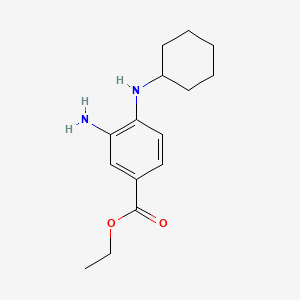Ferroptosis-centered Drug Response Information
General Information of the Drug (ID: ferrodrug0296)
| Name |
Ferrostatin-1
|
||||
|---|---|---|---|---|---|
| Synonyms |
Ferrostatin-1; 347174-05-4; Ethyl 3-amino-4-(cyclohexylamino)benzoate; Ferrostatin-1 (Fer-1); Ferrostatin 1; Fer-1; Benzoic acid, 3-amino-4-(cyclohexylamino)-, ethyl ester; 3-amino-4-cyclohexylaminobenzoic acid ethyl ester; MFCD08072959; 3-amino-4-(cyclohexylamino)-benzoic acid, ethyl ester; ferrrostatin 1; SCHEMBL2032512; CHEMBL3633556; SCHEMBL18137149; CHEBI:173086; UJHBVMHOBZBWMX-UHFFFAOYSA-N; HMS3653M21; BCP17366; EX-A4243; s7243; AKOS003388952; CCG-267075; SB19587; ethyl 3-amino-4-cyclohexylaminobenzoate; Ethyl3-amino-4-(cyclohexylamino)benzoate; NCGC00370951-06; AC-36537; AS-57497; SY270013; HY-100579; CS-0019733; F1302; SW219400-1; C74788; 3-Amino-4-cyclohexylaminobenzoic acid, ethyl ester; A903830; 3-Amino-4-cyclohexylamino-benzoic Acid Ethyl Ester; J-019728
Click to Show/Hide
|
||||
| Structure |
 |
||||
| Formula |
C15H22N2O2
|
||||
| IUPAC Name |
ethyl 3-amino-4-(cyclohexylamino)benzoate
|
||||
| Canonical SMILES |
CCOC(=O)C1=CC(=C(C=C1)NC2CCCCC2)N
|
||||
| InChI |
InChI=1S/C15H22N2O2/c1-2-19-15(18)11-8-9-14(13(16)10-11)17-12-6-4-3-5-7-12/h8-10,12,17H,2-7,16H2,1H3
|
||||
| InChIKey |
UJHBVMHOBZBWMX-UHFFFAOYSA-N
|
||||
| PubChem CID | |||||
Full List of Ferroptosis Target Related to This Drug
Unspecific Target
| In total 1 item(s) under this Target | |||||
| Experiment 1 Reporting the Ferroptosis-centered Drug Act on This Target | [1] | ||||
| Responsed Disease | Degenerative arthritis | ICD-11: FA05 | |||
| Responsed Regulator | Interleukin-1 beta (IL1B) | Driver | |||
| Pathway Response | Fatty acid metabolism | hsa01212 | |||
| Ferroptosis | hsa04216 | ||||
| Cell Process | Cell ferroptosis | ||||
| In Vitro Model | hCDs (Chondrocytes) | ||||
| In Vivo Model |
Thirty-two 8 weeks old male C57BL/6 mice were used in this study. Eight mice were randomly allocated to the sham surgery group. After anesthetized by intraperitoneal injection of pentobarbital (35 mg/kg), sham surgery group were subjected to sham surgery. Then, destabilized medial meniscus (DMM) were performed to establish the OA model in twenty-four mice. DMM mice were randomly divided into three groups (N=8 for each group): the DMM group, the DMM+0.1mg/kg ferrostain-1 group and the DMM+1mg/kg ferrostain-1 group. The DMM+0.1 mg/kg ferrostain-1 group and the DMM+1mg/kg ferrostain-1 group were intraarticularly injected with 0.1 mg/kg or 1 mg/kg ferrostain-1 respectively. The sham surgery group and DMM group were intraarticularly injected with same volume of vehicle. The injection was repeated twice a week for 8 consecutive weeks.
Click to Show/Hide
|
||||
| Response regulation | Both IL-1 and FAC induced ferroptosis related protein expression changes in chondrocytes.In this study, we use Interleukin-1 Beta (IL-1) to simulate inflammation and ferric ammonium citrate (FAC) to simulate the iron overload in vitro. Furthermore, inhibition of ferroptosis, by intraarticular injection of ferrostatin-1, in our case, seems to be a novel and promising option for the prevention of osteoarthritis. | ||||
Phospholipid hydroperoxide glutathione peroxidase (GPX4)
| In total 1 item(s) under this Target | |||||
| Experiment 1 Reporting the Ferroptosis-centered Drug Act on This Target | [2] | ||||
| Target for Ferroptosis | Suppressor | ||||
| Responsed Disease | Lung injury | ICD-11: NB32 | |||
| Pathway Response | Fatty acid metabolism | hsa01212 | |||
| Ferroptosis | hsa04216 | ||||
| Cell Process | Cell ferroptosis | ||||
| In Vitro Model | BEAS-2B cells | Normal | Homo sapiens | CVCL_0168 | |
| In Vivo Model |
The male C57BL/6 mice were divided randomly into 4 groups (n = 4 per group, 8-10 weeks old, weight = 23-25 g): the control group receiving 0.9% NaCl (containing 0.1% DMSO), the LPS group receiving LPS plus 0.9% NaCl (containing 0.1% DMSO), the Fer-1 group receiving Fer-1 only, and the LPS + Fer-1 group receiving both Fer-1 and LPS. The LPS-induced ALI model was induced by instilling intratracheally 50 ul of LPS solution (0.2 g/L), then Fer-1 (0.8 mg/kg) was administered after LPS challenge via tail vein injection. The Fer-1 was dissolved in DMSO first, and diluted with 0.9% NaCl. The final concentration of Fer-1 and DMSO was 0.2 mg/ml and 0.1% respectively.
Click to Show/Hide
|
||||
| Response regulation | The cell viability of BEAS-2B was down-regulated by lipopolysaccharide (LPS) treatment, together with the ferroptosis markers SLC7A11 and GPX4, while the levels of MDA, 4-HNE and total iron were increased by LPS treatment in a dose-dependent manner, which could be rescued by ferrostatin-1. Fer-1 exerted therapeutic action against LPS-induced acute lung injury, and down-regulated the ferroptosis level in lung tissues. | ||||
Cystine/glutamate transporter (SLC7A11)
| In total 1 item(s) under this Target | |||||
| Experiment 1 Reporting the Ferroptosis-centered Drug Act on This Target | [2] | ||||
| Target for Ferroptosis | Suppressor | ||||
| Responsed Disease | Lung injury | ICD-11: NB32 | |||
| Pathway Response | Fatty acid metabolism | hsa01212 | |||
| Ferroptosis | hsa04216 | ||||
| Cell Process | Cell ferroptosis | ||||
| In Vitro Model | BEAS-2B cells | Normal | Homo sapiens | CVCL_0168 | |
| In Vivo Model |
The male C57BL/6 mice were divided randomly into 4 groups (n = 4 per group, 8-10 weeks old, weight = 23-25 g): the control group receiving 0.9% NaCl (containing 0.1% DMSO), the LPS group receiving LPS plus 0.9% NaCl (containing 0.1% DMSO), the Fer-1 group receiving Fer-1 only, and the LPS + Fer-1 group receiving both Fer-1 and LPS. The LPS-induced ALI model was induced by instilling intratracheally 50 ul of LPS solution (0.2 g/L), then Fer-1 (0.8 mg/kg) was administered after LPS challenge via tail vein injection. The Fer-1 was dissolved in DMSO first, and diluted with 0.9% NaCl. The final concentration of Fer-1 and DMSO was 0.2 mg/ml and 0.1% respectively.
Click to Show/Hide
|
||||
| Response regulation | The cell viability of BEAS-2B was down-regulated by lipopolysaccharide (LPS) treatment, together with the ferroptosis markers SLC7A11 and GPX4, while the levels of MDA, 4-HNE and total iron were increased by LPS treatment in a dose-dependent manner, which could be rescued by ferrostatin-1. Fer-1 exerted therapeutic action against LPS-induced acute lung injury, and down-regulated the ferroptosis level in lung tissues. | ||||
References
